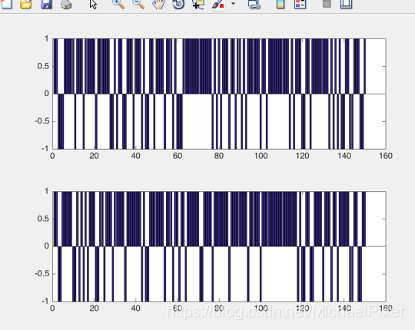2020-05-15更新
鉴于最近关注这个的朋友比较多,好多反映数据失效,之前由于备份硬盘坏了疫情原因也一直没去修,没回复大家,今天找了一下原数据网站的归档地址,新的数据下载地址:
https://archive.physionet.org/physiobank/database/challenge/2016/training.zip
同时也对内容进行补充完善一下,方便大家学习交流
详细分析报告链接:https://pan.baidu.com/s/1n25_z7-ysTRDMva8Elio5A 密码:lph0
1. 要求:
将给定的心音信号分类为正常,异常(即他们需要专家进一步评估以进一步评估或潜在治疗),或者过于嘈杂或模糊三类以进行评估,尽量提高准确率。
程序分为main.m和feature_extraction.m两个文件
2. 程序:
特征提取函数feature_extraction.m采用db6小波特征提取,函数代码如下:
function [ ss ] = feature_extraction(route )
% [x,fs]=audioread('./training-a/a0001.wav');
[x,fs]=audioread(route);
x1=x(:,1); % 抽取第 1 声道
level = 4;
wname ='db6';%选取小波
t=wpdec(x1,level,wname,'shannon');%小波分解
% plot(t);
t0=wprcoef(t,[3,0]);
t1=wprcoef(t,[4,2]);
t2=wprcoef(t,[4,3]);
t3=wprcoef(t,[3,2]);
t4=wprcoef(t,[4,6]);
t5=wprcoef(t,[4,7]);
t6=wprcoef(t,[1,1]);
%构建特征向量
s0=norm(t0);
s1=norm(t1);
s2=norm(t2);
s3=norm(t3);
s4=norm(t4);
s5=norm(t5);
s6=norm(t6);
ss=[s0,s1,s2,s3,s4,s5,s6];%得到7维的特征向量
% figure();
% bar(ss);
end
main.m函数如下:
%%
%本程序读取training-a中150个心音信号作为训练集,后150个心音信号作为测试数据,采用SVM支持向量机和逻辑回归分类器
%进行心音信号的分类
%%
clear;
clc;
rng=[0 1 149 1];%训练 rng=[r1 c1 r2 c2]定义读取csv文件的行列始末段
rng1=[150 1 299 1];%测试
train_label=csvread('./training-a/REFERENCE.csv',0,1,rng);%读取训练标签
for i=1:length(train_label)
if train_label(i)<0
train_label(i)=2;
end
end
test_label=csvread('./training-a/REFERENCE.csv',150,1,rng1);%读取测试标签
for i=1:length(test_label)
if test_label(i)<0
test_label(i)=2;
end
end
figure();
subplot(211);
bar(test_label);%画出测试数据的正确分类标签
%%
%对原始数据进行特征提取,构建n维的训练数据矩阵,样本大小为150
train_data=[];
test_data=[];
for i=1:9
ss=feature_extraction(strcat('./training-a/a000',num2str(i),'.wav'));
train_data=[train_data;ss];
end
for i=10:99
ss=feature_extraction(strcat('./training-a/a00',num2str(i),'.wav'));
train_data=[train_data;ss];
end
for i=100:150
ss=feature_extraction(strcat('./training-a/a0',num2str(i),'.wav'));
train_data=[train_data;ss];
end
%对原始数据进行特征提取,构建n维的测试数据矩阵
for i=151:300
ss=feature_extraction(strcat('./training-a/a0',num2str(i),'.wav'));
test_data=[test_data;ss];
end
%%
%SVM支持向量机分类器
% Factor = svmtrain( train_data,train_label);
% predict_label = svmclassify(Factor, test_data);
% accuracy = length(find(predict_label == test_label))/length(test_label)*100;
% accuracy
% subplot(212);
% bar(predict_label);%绘制预测矩阵与正确答案进行比较
%逻辑回归
Factor = mnrfit(train_data, train_label);
Scores = mnrval(Factor, test_data);
S1=Scores(:,1);
S2=Scores(:,2);
predict_label=[];
for i=1:length(S1)
if S1(i)<S2(i)
predict_label=[predict_label;2];
else
predict_label=[predict_label;1];
end
end
subplot(212);
bar(predict_label);
accuracy = length(find(predict_label == test_label))/length(test_label)*100;
accuracy
3. 分类结果:
使用training-a样本中前150个心音信号样本数据作为训练数据,后150个作为测试数据。
(1)SVM支持向量机的分类结果及准确率:

图1 SVM正确答案(上)与分类结果(下)对比

图2 SVM分类准确率
(2)逻辑回归的分类结果及准确率:
图3 逻辑回归分类器正确答案(上)与分类结果(下)对比

图4 逻辑回归分类准确率
由于只采用了150个信号做训练集,训练好的分类器只有76%的预测率,心音信号来源于https://physionet.org/physiobank/database/challenge/2016/training.zip
REFERENCE.csv形式:





















 4248
4248











 被折叠的 条评论
为什么被折叠?
被折叠的 条评论
为什么被折叠?








